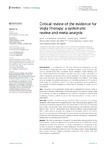Critical review of the evidence for Vojta therapy: a systematic review and meta-analysis

View/
Use this link to cite
http://hdl.handle.net/2183/37470
Except where otherwise noted, this item's license is described as Creative Commons Attribution 4.0 International License (CC-BY 4.0)
Collections
- Investigación (FFISIO) [481]
Metadata
Show full item recordTitle
Critical review of the evidence for Vojta therapy: a systematic review and meta-analysisAuthor(s)
Date
2024-04-22Citation
Sánchez-González JL, Sanz-Esteban I, Menéndez-Pardiñas M, Navarro-López V, Sanz-Mengíbar JM. Critical review of the evidence for Vojta therapy: a systematic review and meta-analysis. Front Neurol. 2024 Apr 22;15:1391448.
Abstract
[Abstract] Introduction: It is essential to link the theoretical framework of any neurophysiotherapy approach with a detailed analysis of the central motor control mechanisms that influence motor behavior. Vojta therapy (VT) falls within interventions aiming to modify neuronal activity. Although it is often mistakenly perceived as exclusively pediatric, its utility spans various functional disorders by acting on central pattern modulation. This study aims to review the existing evidence on the effectiveness of VT across a wide range of conditions, both in the adult population and in pediatrics, and analyze common therapeutic mechanisms, focusing on motor control modulation.
Aim: The goals of this systematic review are to delineate the existing body of evidence concerning the efficacy of Vojta therapy (VT) in treating a broad range of conditions, as well as understand the common therapeutic mechanisms underlying VT with a specific focus on the neuromodulation of motor control parameters.
Methods: PubMed, Cochrane Library, SCOPUS, Web of Science, and Embase databases were searched for eligible studies. The methodological quality of the studies was assessed using the PEDro list and the Risk-Of-Bias Tool to assess the risk of bias in randomized trials. Methodological quality was evaluated using the Risk-Of-Bias Tool for randomized trials. Random-effects meta-analyses with 95% CI were used to quantify the change scores between the VT and control groups. The certainty of our findings (the closeness of the estimated effect to the true effect) was evaluated using the Grading of Recommendations, Assessment, Development, and Evaluations (GRADE).
Results: Fifty-five studies were included in the qualitative analysis and 18 in the meta-analysis. Significant differences in cortical activity (p = 0.0001) and muscle activity (p = 0.001) were observed in adults undergoing VT compared to the control, as well as in balance in those living with multiple sclerosis (p < 0.03). Non-significant differences were found in the meta-analysis when evaluating gross motor function, oxygen saturation, respiratory rate, height, and head circumference in pediatrics.
Conclusion: Although current evidence supporting VT is limited in quality, there are indications suggesting its potential usefulness for the treatment of respiratory, neurological, and orthopedic pathology. This systematic review and meta-analysis show the robustness of the neurophysiological mechanisms of VT, and that it could be an effective tool for the treatment of balance in adult neurological pathology. Neuromodulation of motor control areas has been confirmed by research focusing on the neurophysiological mechanisms underlying the therapeutic efficacy of VT.
Keywords
Vojta therapy
Meta-analysis
Neurophysiotherapy
Neurorehabilitation
Reflex locomotion therapy
Systematic review
Meta-analysis
Neurophysiotherapy
Neurorehabilitation
Reflex locomotion therapy
Systematic review
Description
Systematic review
Editor version
Rights
Creative Commons Attribution 4.0 International License (CC-BY 4.0)
ISSN
1664-2295






